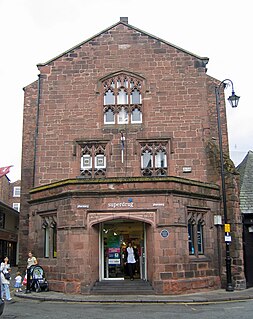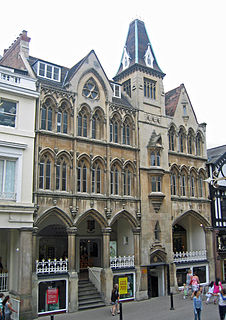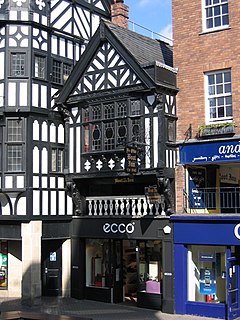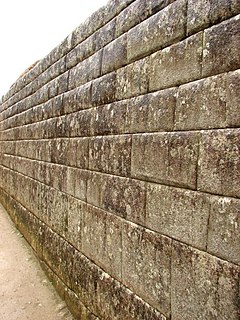
St Nicholas' Chapel is a former chapel in St Werburgh Street, Chester, Cheshire, England. Since it ceased functioning as a chapel it has had a number of uses, including being at one time a theatre. It is now used as a shop. It is recorded in the National Heritage List for England as a designated Grade II listed building, and is a scheduled monument.

The Abbey Gateway is in Chester, Cheshire, England and leads from Northgate Street into Abbey Square. It is recorded in the National Heritage List for England as a designated Grade I listed building.

Chester Rows consist of covered walkways at the first floor behind which are entrances to shops and other premises. At street level is another set of shops and other premises, many of which are entered by going down a few steps. The Rows, found in each of the four main streets of the city of Chester, Cheshire, England, are unique.

Crypt Chambers is at 28–34 Eastgate Street and 34–40 Eastgate Row, Chester, Cheshire, England. It is recorded in the National Heritage List for England as a designated Grade I listed building and incorporates a section of the Chester Rows.

Cowper House is a former town house at 12 Bridge Street, Chester, Cheshire, England. It is recorded in the National Heritage List for England as a designated Grade I listed building, and it incorporates a section of the Chester Rows.

1 Bridge Street, Chester, is located at the junction of Bridge Street and Eastgate Street at Chester Cross in the centre of the city of Chester, Cheshire, England. Its architecture is that of the black-and-white revival, it incorporates part of the Chester Rows, and is recorded in the National Heritage List for England as a designated Grade II* listed building. Because of its prominent position and its black-and-white architecture, the historian Simon Ward has described it as an "iconic" building.

The Public Baths are on the north side of Union Street at its junction with Bath Street in Chester, Cheshire, England. The structure is recorded in the National Heritage List for England as a designated Grade II listed building.

3–31 Northgate Street is a terrace of shops, offices and a public house on the west side of Northgate Street, Chester, Cheshire, England. All the buildings have a set-back ground floor with a covered walkway, are timber-framed in their upper storeys, and are listed buildings, being graded II* or II. The part of the terrace comprising numbers 5–31 is known as Shoemakers' Row, or Sadler's Row.

St Oswald's Chambers consists of a commercial property at 20–22 St Werburgh Street, Chester, Cheshire, England. It is recorded in the National Heritage List for England as a designated Grade II listed building.

St Werburgh Chambers consists of a pair of shops in St Werburgh Street, Chester, Cheshire, England, on the south side of the street facing Chester Cathedral. It is recorded in the National Heritage List for England as a designated Grade II listed building.

30 Bridge Street, Chester is a shop in Chester, Cheshire, England. It stands on a corner on the west side of the street and the south side of Commonhall Street, and contains a section of the Chester Rows. It is recorded in the National Heritage List for England as a designated Grade II listed building.

The Boot Inn is at 17 Eastgate Street and 9 Eastgate Row, Chester, Cheshire, England. It is recorded in the National Heritage List for England as a designated Grade II* listed building. The building consists of a shop occupying a former undercroft at street level, above which is a public house at the level of the Row and above.

The Pied Bull Hotel is located at 57 Northgate Street, on the corner of King Street, Chester, Cheshire, England. It is recorded in the National Heritage List for England as a designated Grade II* listed building.

The Dutch Houses are at 20, 22 and 24 Bridge Street Row, Chester, Cheshire, England. They are recorded in the National Heritage List for England as a designated Grade II listed building.

Park House is at 37–41 Lower Bridge Street, Chester, Cheshire, England. It is recorded in the National Heritage List for England as a designated Grade II listed building.

The Blue Coat School is located in Upper Northgate Street, Chester, Cheshire, England. It is recorded in the National Heritage List for England as a designated Grade II* listed building.

The Old Bishop's Palace is located in an elevated position overlooking The Groves and the River Dee in Chester, Cheshire, England. It is recorded in the National Heritage List for England as a designated Grade II* listed building.

Forest House is in Love Street, Chester, Cheshire, England. It is a former town house that is recorded in the National Heritage List for England as a designated Grade II listed building.

Watergate House is in Watergate Street, Chester, Cheshire, England. It is recorded in the National Heritage List for England as a designated Grade II* listed building.

























